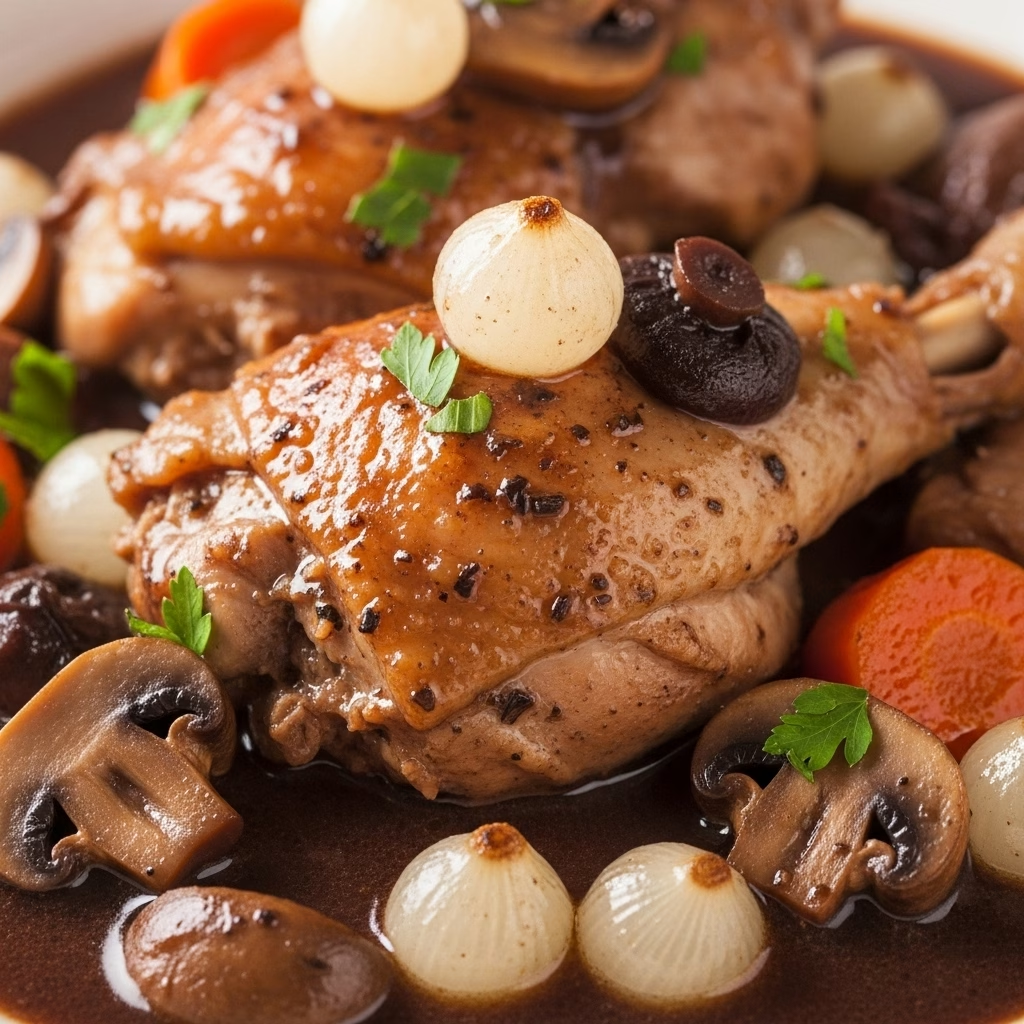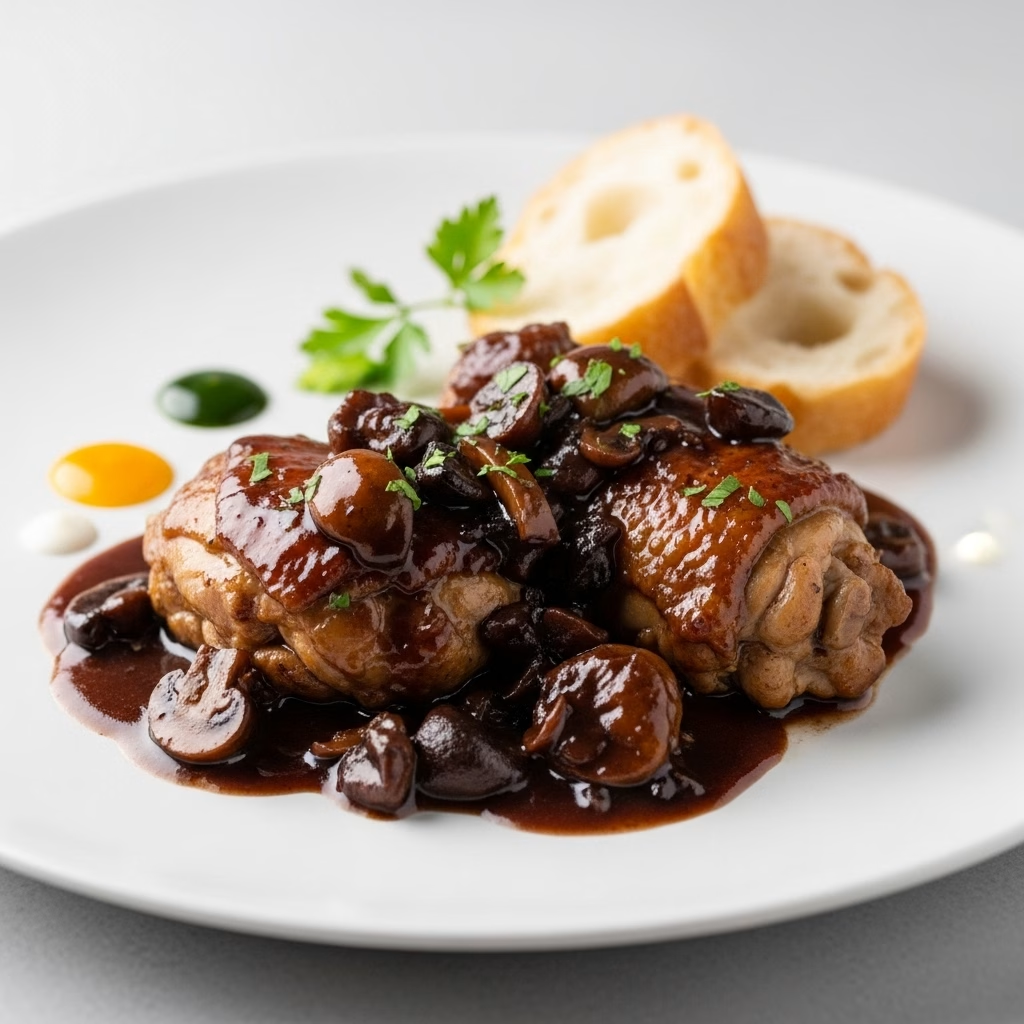Coq au Vin (France), meaning “rooster in wine,” is one of the most iconic and rustic dishes in traditional French cuisine.
This beloved dish is known for its rich, deep flavors and comforting nature. Traditionally slow-cooked, it transforms humble ingredients into a luxurious meal. In this guide, we’ll explore everything from ingredients and cooking instructions to serving tips, healthier alternatives, and even the fascinating history behind it.
Whether you’re a seasoned cook or an enthusiastic beginner, this comprehensive recipe will help you master Coq au Vin like a true French chef.
Table of Contents
Ingredients for Coq au Vin (France)
This recipe serves 6 people. Prep time: 25 minutes | Cook time: 2.5 to 3 hours
Main Ingredients:
- 1 whole chicken (around 1.5 kg), cut into 8 pieces (traditionally a rooster was used)
- 750 ml red wine (preferably Burgundy or Côtes du Rhône)
- 2 cups chicken stock
- 150g pearl onions or shallots, peeled
- 200g button mushrooms, halved
- 150g thick-cut bacon or pancetta, cubed
- 3 cloves garlic, minced
- 2 medium carrots, sliced
- 1 medium onion, chopped
- 2 tablespoons tomato paste
- 2 tablespoons flour
- 2 tablespoons olive oil
- 2 tablespoons unsalted butter
- 1 bay leaf
- 3 sprigs fresh thyme
- Salt and freshly ground black pepper to taste
- Fresh parsley for garnish
Step-by-Step Instructions for Coq au Vin (France)
1. Marinate the Chicken (Optional but Recommended)
Place the chicken pieces in a large bowl or container. Add sliced carrots, chopped onion, garlic, thyme, and bay leaf. Pour the red wine over the top to fully submerge the chicken. Cover and refrigerate for at least 12 hours or overnight.
2. Prepare the Ingredients
- Drain the chicken, reserving the marinade and vegetables separately.
- Pat the chicken pieces dry with paper towels for better browning.
- Season the chicken with salt and pepper.
- Strain the marinade and set the wine aside.
3. Sear the Chicken
Heat 1 tablespoon olive oil and 1 tablespoon butter in a heavy-bottomed Dutch oven or casserole over medium-high heat. Brown the chicken pieces on all sides until golden, working in batches if needed. Set aside.
4. Cook the Bacon
In the same pot, add the bacon cubes and cook until crispy. Remove and set aside, leaving the fat in the pot.
5. Sauté Aromatics
Add the marinated vegetables (onion, garlic, carrot) to the pot. Cook for about 5-6 minutes until softened and aromatic. Stir in the tomato paste and cook for 2 minutes.
6. Create the Base
Sprinkle the flour over the vegetables and stir well to coat evenly. Cook for another 2 minutes to remove the raw taste of the flour. This will help thicken the stew later.
7. Deglaze and Simmer
Slowly pour in the reserved red wine while scraping the bottom of the pot to lift any browned bits. Add the chicken stock and stir. Return the chicken and bacon to the pot. Add bay leaf and thyme.
8. Braise the Chicken
Bring the mixture to a gentle boil, then reduce to low heat. Cover the pot and simmer for 2 hours, or until the chicken is fork-tender.
9. Cook the Mushrooms and Pearl Onions
While the chicken is braising, heat the remaining butter and olive oil in a separate skillet. Sauté the mushrooms until browned and the pearl onions until tender and caramelized. Season lightly with salt and pepper.
10. Final Touch
In the last 20 minutes of cooking, add the mushrooms and onions to the pot. Allow the flavors to meld together.
11. Garnish and Serve
Remove the bay leaf and thyme sprigs. Garnish with freshly chopped parsley and serve hot.

Serving Suggestions for Coq au Vin (France)
- Classic pairing: Serve over creamy mashed potatoes, which absorb the rich wine sauce beautifully.
- French style: Pair with crusty French baguette slices or a rustic sourdough to mop up the sauce.
- Comfort dish: Polenta or buttered noodles make a comforting and hearty base.
- Vegetable pairing: A simple green salad with vinaigrette or haricots verts (French green beans) complements the dish’s richness.
Wine pairing tip: Serve with the same red wine used in the dish for the most harmonious flavors.
Tips for Perfect Coq au Vin
- Use good wine: Always cook with wine you’d enjoy drinking. The better the wine, the richer the sauce.
- Don’t rush: Long, slow cooking is essential for tender meat and flavor development.
- Pat the chicken dry: Moisture prevents good browning—dry chicken equals deeper flavor.
- Cook mushrooms separately: This ensures they stay golden and don’t turn soggy in the stew.
- Strain marinade: This avoids bitterness and ensures a smoother sauce texture.
Healthier Alternatives for Coq au Vin (France)
- Lean protein: Use skinless chicken thighs or breasts instead of a whole bird to reduce fat content.
- Turkey option: Turkey thighs or legs can mimic the rich texture of traditional rooster.
- Less wine: Use half the amount of wine and increase the chicken stock to lower alcohol and calories.
- Light sauté: Reduce butter/oil or use a cooking spray.
- Skip bacon: Use smoked paprika or turkey bacon for a lower-fat smoky flavor.
Creative Variations of Coq au Vin
- Coq au Vin Blanc: Substitute red wine with dry white wine (like Chardonnay) for a lighter dish.
- Provençal style: Add olives, tomatoes, and herbes de Provence for a Southern French twist.
- Mushroom-forward version: Add wild mushrooms like chanterelles or porcini for an earthy depth.
- Vegetarian Coq au Vin: Use seitan or portobello mushrooms in place of meat, vegetable stock, and red wine.
- Instant Pot version: Pressure cook the dish in 30-35 minutes instead of slow braising.
Common Mistakes to Avoid
- Using poor quality wine: This leads to a bitter, unpleasant sauce.
- Undercooking: Rushing the braising time results in tough meat and weak flavor.
- Crowding the pan: Always sear in batches; overcrowding steams rather than browns.
- Not reducing sauce: The final sauce should be thick and luscious, not watery.
- Skipping the marinade: While optional, marinating builds deeper layers of flavor.
History of Coq au Vin (France)
The origins of Coq au Vin (France) date back centuries, rooted in the resourceful culinary traditions of French peasants. The name literally translates to “rooster in wine,” and the dish was a method to tenderize old roosters through slow cooking in a rich wine-based sauce. As such, it is believed to have rural, provincial origins, likely from Burgundy, where wine and poultry were abundant.
Historical mentions of similar recipes go as far back as Roman times, but Coq au Vin as we know it became popularized in the 20th century. It was elevated from farmhouse fare to a national culinary treasure by the likes of Julia Child, who introduced it to American audiences in her landmark cookbook Mastering the Art of French Cooking. This turned Coq au Vin into a globally recognized symbol of French gastronomy.
Despite its humble beginnings, the dish encapsulates the spirit of French cooking: transforming simple, often tough ingredients into refined and soul-satisfying cuisine through technique, patience, and love of flavor. Today, it is a staple in bistros and fine-dining establishments alike, cherished for its rich taste and cultural significance.
FAQs about Coq au Vin (France)
1. What kind of wine should I use for Coq au Vin?
Use a dry red wine like Burgundy, Pinot Noir, or Côtes du Rhône. Avoid sweet or heavily oaked wines.
2. Can I make Coq au Vin in advance?
Yes! In fact, it tastes better the next day after the flavors meld together. Simply reheat gently.
3. Can I freeze Coq au Vin?
Absolutely. Cool it fully, transfer to airtight containers, and freeze for up to 3 months.
4. What’s the best chicken cut for Coq au Vin?
Bone-in thighs and drumsticks are ideal. They stay juicy and absorb flavor well.
5. Is marinating the chicken necessary?
It’s optional but highly recommended for a deeper flavor and more tender meat.
6. How do I thicken the sauce?
Flour added before simmering helps, or reduce the sauce after cooking until thickened.
7. Can I use white wine instead of red?
Yes, that variation is called Coq au Vin Blanc and is equally delicious with cream and mushrooms.
8. What if I don’t eat bacon?
Skip the bacon or substitute with smoked turkey or a splash of liquid smoke for flavor.
9. Is this dish suitable for children?
The alcohol cooks off during the long simmering, leaving just the flavor—making it safe for kids.
10. What side dishes go best with Coq au Vin?
Mashed potatoes, noodles, polenta, or crusty bread are classic accompaniments.
Coq au Vin (France) is a timeless French dish that showcases the elegance of slow-cooked, hearty food. With deep, layered flavors of wine, herbs, and tender chicken, it’s a perfect meal for special occasions or intimate family dinners.
While the traditional method takes time, the end result is well worth the wait. From its rustic roots to its present-day sophistication, Coq au Vin remains a celebration of French culinary artistry. Follow this detailed guide to bring a taste of France into your kitchen, and enjoy the soulful warmth this dish provides.


